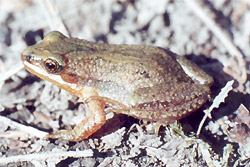Pseudacris maculata
Boreal Chorus Frog
Identification
The Boreal Chorus Frog is brown with three dark lateral stripes or rows of spots along its back, in contrast to the Spring Peeper’s dark “X”. Boreal Chorus Frogs have a slight black mask, a white upper lip, and they do not have dorsolateral ridges. They only measure about 1 inch long.
Their ascending call sounds similar to someone running their fingers over the teeth of a comb. It is sometimes confused with the broken call of a Spring Peeper but it sounds tinny and mechanical as opposed to the musical whistle of a Spring Peeper. It has been heard in April and May in Vermont, more commonly in the second half of April.
The females lay 500-1,500 eggs in groups of 20-300 in loose gelatinous clusters.
Range/Habitat
They are found in herbaceous vegetation near heavily-vegetated bodies of water. They also need a shallow open breeding area. They were historically found in Grand Isle and Franklin Counties, but have not been seen or heard since 1999.
Status
This species has a state natural heritage rank of S1(rare). The Boreal Chorus Frog has been designated a Species of Greatest Conservation Need (high priority) in Vermont’s Wildlife Action Plan and is endangered in Vermont. Please report all sightings of this species in Vermont. Take photos if possible. Even historic sighting information is useful.
More Info
Pseudacris triseriata (Western Chorus Frog) was classified as Psuedacris maculata (Boreal Chorus Frog) in 2007.
- Pseudacris triseriata at Animal Diversity website
- Pseudacris triseriata at Amphibiaweb
- Pseudacris maculata at the CARCNET website
- Pseudacris triseriata in the Vermont Agency of Natural Resources’ Wildlife Action Plan (PDF)
- Listen to its calls
at Animal Diversity (.aiff or .mp3 format)
at AmphibiaWeb (.wav format)
at CARCNET (.wav format)
or at Frog Quiz (QuickTime format)
Species summary written by Kaile Burgess.


